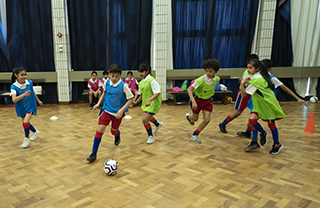Start your journey

How to use the England DNA in your coaching session
- The Boot Room
- 18 June 2020
The traditional approach to training sessions has been to move from a technique practice to a skill-based practice then into a small-sided game. This seems to have a vice-like grip on coaches and the development of young players.
It must be stated that for some coaches and players this process works. There's a logical progression through the session and for the players there’s a gradual build-up of challenge and decision-making. It may be because of this that the method is so difficult to break.
However, this process means that the players are only getting a small percentage of the very thing they need to get better at – the game of football – and unfortunately, some coaches only use ‘the game’ as the carrot for the players to ensure full attention and commitment during the other parts of the session.
In many cases the ‘other parts’ aren’t close enough to the demands of the game. The level of decision-making can be very low or non-existent and players can find it difficult to transfer what they’re being asked to do into the real game.
This has to stop in order to allow your players to develop further. More and more of your coaching sessions should include opportunities to explore and experiment.
During the planning of your session, the Foundation Phase DNA is asking you to consider starting with a game. This gets your players motivated immediately and gets the session off to a powerful start. This is perfect for players of all ages.
The game can be part of an arrival activity or be a game with quite specific team and individual challenges depending upon the theme or topic of the session. This is a great way to begin the session.
Your planning process should include some consideration of the following (after you've decided upon the overall theme or topic):
- What area or pitch size should be used? Think, do the players need to be given space? A big pitch might be used to counter-attack or to promote more running with the ball. A smaller pitch might be to challenge players to find space or to deal with playing under pressure.
- Should there be goals; lines to stop the ball on; target areas to penetrate etc? Again, this relates to your overall theme. Do you have goalkeepers? If you do, adding direction and goals is a great start. The use of zones, areas or targets can be useful for specific things, but try not to stray too far from the game.
- How many should be on each team and which players are put together? This needs careful consideration and is a great way to begin to meet the individual needs of players. Teams can be matched up, under or overloaded, and choosing who plays on each team should depend upon what areas you're trying to challenge, improve or practise most.
- What rules, conditions or constraints will you place on the game? This can be as simple as: players must try to keep the ball on the pitch at all times (no aimlessly ‘booting’ the ball out or up-field with no thought) to quite sophisticated individual challenges relating to body position, type of pass or run as the game goes on.
- What will the overall session look like? Will the game go on for the whole time as there are different challenges to be used? Will the game be broken up with small number activities that support the overall theme? Will you provide completely different activities so that when players go back into the game they have to remember it and what they need to do to be successful?
It’s important to still provide sessions that include individual ball work, small-number practices to develop technique, skill and decision-making for your players. If you believe that using this approach is the best and most appropriate way of helping and supporting your players, that’s fine, but the more time spent on games of different formats and played on different pitch sizes in a Foundation Phase training session, the better. It’s only by breaking the very strong chains of tradition, and including more game-like activities, that more progress will be made.
The time spent planning will greatly enhance your enjoyment of the session and accelerate the development of your players – if you’ve carefully thought about including more game-like activities in the time you’re with your team.
To learn more about Foundation Phase DNA, click here.




















